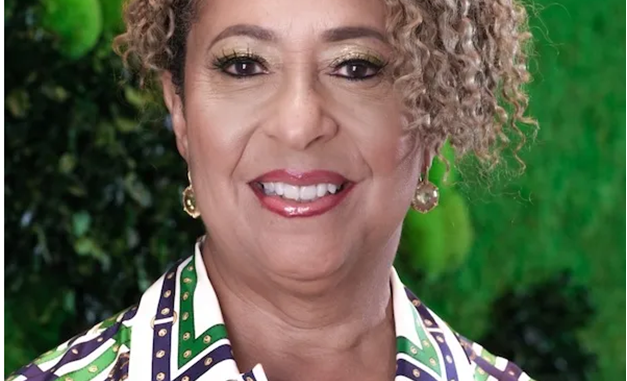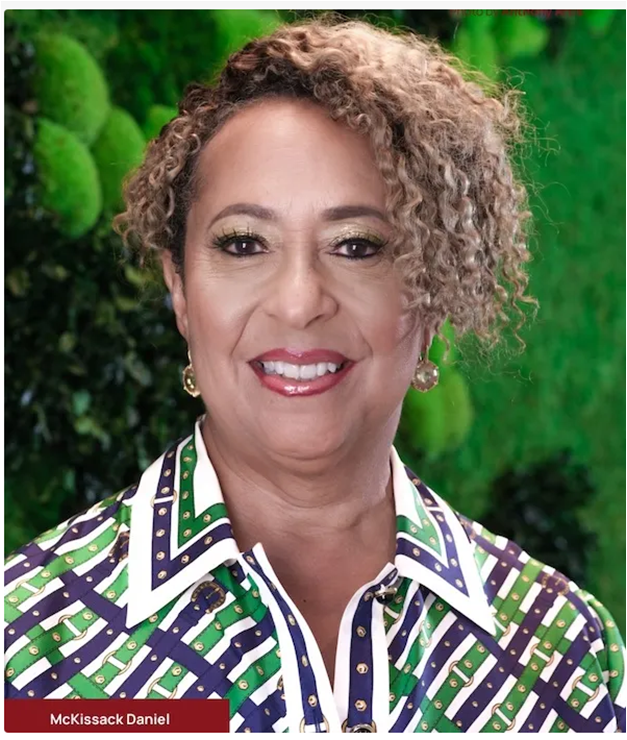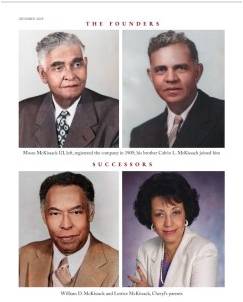

BY GILLIAN GLASCO – www.sundaybestmagazine.com – Far too often the ingenuity and contributions of Black Americans are erased, hidden, or simply never acknowledged in the history of the United States.
The legacy of exploited labor and the subjugation of enslaved Africans in this country has sustained a marginalized view of Black humanity and abilities. Not only did the enslaved have to survive unimaginable adversity, the accomplishments of their descendants are largely unsung.
Cheryl McKissack Daniel embodies the innovation, talents, and faithful spirit that has enabled Black Americans to persevere.
Cheryl McKissack Daniel is the President and CEO of McKissack & McKissack, the oldest Black owned—and woman led—professional design and construction firm in the United States. For 118 years this family-owned business has been a pillar in the construction and design community, carrying on a legacy that was birthed in bondage. McKissack today has 150 employees with annual revenues of $50 million. Next year’s projection is $60 million.
When you walk into the McKissack office in midtown Manhattan, it’s hard not to be in awe. Not simply because of the lush, grassy accent wall, donning the bright red McKissack emblem, or the gentle silence and cool air of the lobby, but of the history that made it all possible. The legacy wall provides a glimpse of the McKissack family members that passed the baton each generation, expanding their expertise and scope to amass more than 6,000 planning, design, and construction projects to date.
This five generation succession requires vision, focus, and a commitment to family. McKissack Daniel’s great-great-grandfather, Moses McKissack I, was born of the West African Ashanti empire and sold into slavery to William Mckissack of North Carolina. While enslaved Moses was taught brick making. This skill would change the trajectory of the Mckissack family for years to come. McKissack Daniel states, “He had to overcome slavery and the mentality of being enslaved, to have the foresight that he wanted something better. And to have something better he needed a craft.” Moses passed on the trade of brick making to his son Moses II, a free man, who went on to become a master builder, who specialized in spiral staircases and gingerbread finishes, most notably for the Maxwell House Hotel in Nashville, TN.
The early post-emancipation era allowed craftsmen and artisans like the first two Mckissack men to sell their bricks and start businesses, as the labor and skills of freed Blacks were still in high demand. Moses III followed in the footsteps of the first two, learning the art of building from his father Moses II, and becoming an accomplished carpenter. He received his formal education in segregated Pulaski public schools and established the McKissack & McKissack firm in 1905 in Nashville. Eventually teaming up with his brother Calvin L. McKissack, the firm’s first major commission was to design the Carnegie Library on the Fisk University campus.
By the 1920s it was unpopular for Blacks to work side by side with whites and do business. While working throughout the South in Black institutions, schools, churches, and universities, it was not safe for Moses III and his crew to travel at night because Blacks were being killed and they couldn’t patronize hotels and restaurants. They navigated this time staying with friends and relatives, splitting the day time between traveling and construction.
Racism always required the McKissack family to pivot and recalibrate. They encountered another stumbling block when Tennessee instituted a registration law for architects in 1922 and the McKissack Brothers were initially denied. But after petitioning the state and acquiring architectural degrees, Moses Mckissack III became the first Black licensed architect in the United States, on May 27th 1922, with certificate number 117. He was followed by his brother Calvin with certificate number 118 on the same day.

In the late 1930s McKissack & McKissack received several federal Works Progress Administration (WPA) contracts. The WPA was a U.S.-backed jobs program to help lift the economy out of the depression. In 1942 the company received a $5.7 million contract—the equivalence of about $107 million in 2023 dollars—for construction of the Ninety-ninth Pursuit Squadron Air Base for the African American combat air unit in Tuskegee, Alabama. This World War II contract was the largest ever granted by the federal government to an African American company. The McKissacks also designed several federal housing projects and Moses McKissack III received an appointment to the White House Conference on Housing Problems during President Franklin Delano Roosevelt’s administration.
Following the death of his brother, Calvin L. McKissack became president and general manager of the firm until his own death in 1968. The reins were passed to Moses III’s son, William D. McKissack, Cheryl McKissack Daniel’s father. The family described William as a “Good ole’ Boy” having business associates in Black and white communities. He developed strong relationships with politicians and other contractors, collaborating on joint ventures all across Nashville, and led construction on twenty historically Black colleges. Unfortunately William D. McKissack suffered a stroke that would require a change in leadership. And though the family was under pressure to sell their blossoming business, it was McKissack Daniel’s mother, Leatrice Mckissack, a long time stay-at-home mom, who rose to the occasion.
“Now when my Mother took over, they were not ready for that,” McKissack Daniel recalls. Many people were not accustomed to having a woman in a powerful leadership role. She had to clean house and “change her senior management team at the office, so they could appreciate the fact that she was running the business and not my father,” McKissack Daniel adds.
The matriarchal McKissack may have been an unexpected CEO but she was ready for the challenge. McKissack Daniel says, “Yet when she had to make a business decision on a dime, not only did Mom’s education and prior experience in the workforce kick in, coupled with her family’s prominence in the community and the McKissack’s legacy as builders surviving enslavement, filled within her the fortitude to keep the business in the family for the sake of her daughters. I am grateful that she groomed and prepared me to become the 5th generation president and CEO of the family’s original business.” Her mother had a Master’s in Psychology.
When it was time for McKissack Daniel to start her collegiate journey her father said, “You can attend any college in the world, but I’m only paying for Howard University”. And he meant it. “He was a Howard University alumnus and proud of his alma mater,” McKissack Daniel says. “And while it may be a risky move today, Howard was the only school I applied to and thank goodness, I got in! In hindsight, I realize just why Howard was so important to my father.”
In addition to her parents always stressing the importance of education, the HBCUs were and are “the epitome of Black excellence in every facet,” she adds. “It prepared me for the real world. If you can navigate Howard’s registration and bursar’s office, you can accomplish anything. No task is too hard, it only takes a little finesse. That’s a priceless life lesson for all seasons.”
Cheryl McKissack Daniel received her bachelor’s and master’s degree in civil engineering from Howard University. And while she valued her on-the-job training from her mother and the Southern roots that built the company, she always had her sights set on New York City. But bringing the McKissack business to the Big Apple was uncharted territory. Though McKissack Daniel possessed an impressive portfolio of work, supported by her family’s outstanding reputation in the South, that didn’t hold weight in New York City. Coming to New York meant starting over.
In order to get over the hump and make an impact in New York she committed to a razor focused strategy. “I chased the money,” McKissack Daniel says. She went after the construction, finance, and project management agencies that had the highest amount in their budget for capital programs. Agencies such as the Dormitory Authority of the State of New York (DASNY) and the New York City School Construction Authority (NYCSCA). “Every event that they had, every opportunity for me to speak to a board member, a president, a CFO, a procurement officer, or a secretary, I developed relationships with them. I pursued business relationships and made alliances with large construction managers such as Turner Construction, Skanska Construction, and Lend Lease construction. I knew they were going to need a M/WBE to put on their team to go after these contracts once the legislation passed. I made sure I was that preferred person.”
M/WBE refers to Minority and Women-owned Business Enterprise.
The M/WBE legislation was a helpful tool to create opportunities for minority business owners, but the field of access was still narrow, as minority meant all non-white ethnicities and women of all cultures and races could fill that M/WBE quota. But McKissack Daniel’s networking abilities and shrewd tactics worked in her favor. Her strategy was “Learn the client, develop relationships with the client, learn how to build in New York City with my strategic alliances, and steal their people.” (Here we shared a big laugh). This was the formula that would allow her to become independent. She states, “Building staff, building reputation, and building relationships was for the purpose of becoming a prime contractor.”
A prime contractor is a contractor without a partner. There is often an assumption that minority companies are not up to the task or will need the backing and partnership of other firms. The process of becoming a prime contractor is an arduous one. McKissack Daniel states, “It’s a constant proving of yourself, taking itty bitty steps and not being able to leap frog. Because when people look at minority companies they look to eliminate. They look to throw a road block. They don’t look at what the potential is, like we do when we bring on our minority contractors.”
Much like her great-great-grandfather she banks on the capability and skills of her people, that have been historically shut out, no matter how challenging the landscape. She advises, “You have to be thick-skinned, self-motivated, and deliver on your promise. That’s just good business.”
As a result, under her leadership, the Mckissack & Mckissack firm is responsible for $50 billion worth of construction projects, including the new Terminal One at JFK International Airport, the LaGuardia Airport Central Terminal building redevelopment and the Coney Island Hospital campus renovation. McKissack Daniel also credits being the independent engineer for the MTA for fourteen years as a cornerstone in her career. Winning the MTA contract set them up for transit work across the country in addition to moving the Atlantic Yards rail to make way for the Barclay Center in Brooklyn. She states, “This really moved the needle for Mckissack & McKissack.”
A legacy like this does not occur by happenstance. Education has been key to their advancement. McKissack Daniel says, “Construction now is not like trade school.” A degree in architecture, engineering, and construction management are essential to be a part of technical teams to manage construction work. Entering into this field requires guidance and engaging with students at a young age helps expose them to the possibilities of this industry.
McKissack Daniel is paying it forward as a national board member of ACE Mentor Program of America. ACE goes into high schools once a week and mentors in the field of architecture, construction, and engineering. The program culminates with the students building their own project, based on a McKissack job. She explains, “If we have a project in Brooklyn the whole team working on that project, from the architect, to the engineer, to the contractor will put together the curriculum for that school. The kids also get to come to the construction site. I love ACE.”
She also works with The National Association of Minority Contractors (NAMC) and they are looking to build an entrepreneur/training center. The entrepreneur outreach will bring in individuals that want to start their business and guide them in the right direction with their business plan and give them access to resources, while the training facility will focus on trades. She is the chair of the New York Building Congress Foundation whose charity event she was whisking away to that evening as soon as our interview concluded. In cooperation with New York City Schools Chancellor David C. Banks, McKissack & McKissack is adopting a school focusing on vocation/trades and bringing in union leaders to help facilitate this effort.
As the future continues to unfold McKissack Daniel says, “I look forward to the next venture while growing our construction business.” She and John Rice founded Legacy Engineers in 2019. Though the pandemic was looming it didn’t hurt their business because there were so few Black-owned mechanical, electrical, and plumbing/fire protection engineering firms. It’s grown from the two founders to fifteen people, an office in Atlanta, and they are looking to open all along the east coast. Her goal is to have a thriving pool of Black engineers to turn the business over to and continue to create Black business owners.
To stay ready for the next chapter McKissack Daniel finds inspiration in many texts. She sites, “The Ideal Team Player,” and “The Five Dysfunctions of A Team,” by Patrick Lencioni; “Good to Great,” by Jim Collins, and “The Alchemist,” by Paulo Coelho just to name a few. She says, “We have used all these books in our strategic planning over the years.” And for her spiritual grounding she relies on the Bible and “Jesus CEO” by Laurie Beth Jones. “Jesus CEO,” offers five Ps that McKissack Daniel has used every step of the way: Perseverance; persistence; preparedness; productivity, and prayer.
Chandra McQueen, President of Moona Media & Management who works closely with the company, often says McKissack Daniel and her family are “The Hidden Figures of construction,” a reference to the three brilliant Black scientists—Katherine Johnson, Dorothy Vaughan and Mary Jackson—who played a critical role in NASA during the development of the U.S. space program and were subjects of the 2016 feature film “Hidden Figures.”
Indeed. They are a revolutionary Black American institution that should be celebrated.
“This extraordinary family exemplifies a dedication to craft and community. They invested in skills that couldn’t be taken away, constructing their destiny brick by brick.”
For more visit: www.mckissack.com
Article retrieved from:
www.sundaybestmagazine.com/cheryl-mckissack-daniel-the-hidden-figure-of-construction-industry

Be the first to comment